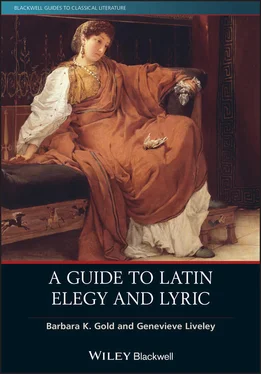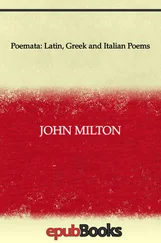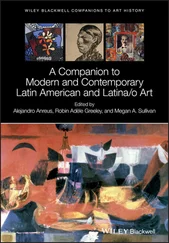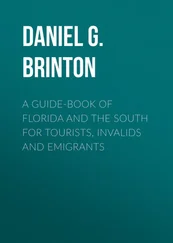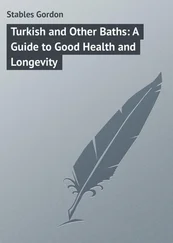Too little of Gallus’ own writing has survived for us to be able to do more than speculate on the content of his own elegies – although a combination of sorrow and love appears to be the theme of at least one surviving fragmentary line, in which Gallus declares himself to be “Sad, Lycoris, because of your misbehavior” ( Tristia nequit[ia … .]a, Lycori ). Yet his influence upon the shape of the elegiac genre in Rome is unquestionable. Propertius explicitly names Gallus – along with fellow Roman elegists Calvus (whose poetry similarly does not survive) and Catullus (who also writes lyric poetry) – as he ambitiously declares a connection between his own work and this venerable canon of earlier Roman elegists (2.34.87–94):
haec quoque lascivi cantarunt scripta Catulli,
Lesbia quis ipsa notior est Helena;
haec etiam docti confessa est pagina Calvi,
cum caneret miserae funera Quintiliae.
et modo formosa quam multa Lycoride Gallus
mortuus inferna vulnera lavit aqua!
Cynthia quin etiam versu laudata Properti,
hos inter si me ponere Fama volet.
(So too did the poems of playful Catullus sing
through which Lesbia is better known than Helen herself;
and so too did the pages of learned Calvus confess,
when he sang of the death of poor Quintilia.
And just recently, how many wounds has Gallus washed in
the waters of the underworld, dead because of Lycoris’ beauty.
Yes, Cynthia will live, praised by the verses of Propertius,
if Fame grants me a place among these poets.)
In Amores 3.9, Ovid’s elegiac tribute to the poet Tibullus following his death in 19 bce, Ovid presents this same sequence of elegists – Calvus, Catullus, and Gallus – coming forward to greet Tibullus when he too arrives in the Elysian Fields of the afterlife ( Amores 3.9.61–4). And in his autobiographical Tristia (which literally translates as “Sorrows” or “Sad Songs”), Ovid adds his own name to a distinctively Roman elegiac canon that begins with Gallus, then continues through Tibullus and Propertius, until it reaches Ovid himself ( Tristia 4.10.51–4):
Vergilium vidi tantum, nec avara Tibullo
tempus amicitiae fata dedere meae.
successor fuit hic tibi, Galle, Propertius illi;
quartus ab his serie temporis ipse fui.
(Vergil I only saw, and to Tibullus selfish Fate
gave no time for friendship with me.
He was your successor Gallus, and Propertius was his:
after them, fourth in line, was me.)
By repeatedly representing themselves as the successors of Roman as well as of Greek poets, Propertius and Ovid together manage to establish Roman elegy as a distinctive genre in its own right. Writing in the late first century ce, the Roman critic and rhetorician Quintilian could therefore proudly claim that (10.1.93):
Elegia quoque Graecos provocamus, cuius mihi tersus atque elegans maxime videtur auctor Tibullus. Sunt qui Propertium malint. Ovidius utroque lascivior, sicut durior Gallus.(In elegy as well we challenge [literally – “we call out”] the Greeks; for me, its most concise and elegant author seems to be Tibullus, but there are those who prefer Propertius. By comparison, Ovid is more playful, just as Gallus is tougher/more serious.)
Quintilian’s ranking of the Roman elegists has not always influenced popular or scholarly opinion of this canon, as we will see in the following chapters. Yet it reminds us just how successfully the Romans adopted and adapted this ancient Greek literary form, and how effectively they made elegy their own.
Literary Contexts for Lyric: Genre and Canon
In Homer we find bards reciting epic poetry accompanied by the lyre ( Odyssey 8.66) and archaic Greek poets such as Alcaeus and Sappho are supposed to have sung their lyric poetry to live audiences accompanied – just as the name suggests – by the music of a lyre. However, it wasn’t until much later, in the Hellenistic period (the historical period between the death of Alexander the Great in 323 bce and the birth of the Roman Empire in 31 bce), that lyric poetry came to be defined essentially by its meter. Or rather, by its meters – plural . For, unlike epic (which is defined as poetry written in hexameter verse) and elegy (which is written in couplets made up of paired lines of verse, namely a hexameter line followed by a pentameter line), lyric poetry uses lots of different meters. Some of these are named after the ancient Greek poets who originally composed the first known lyric poetry: Alcaeus, Alcman, Anacreon, Bacchylides, Ibycus, Pindar, Sappho, Simonides, and Stesichorus. In fact, these nine poets came to represent a formal lyric canon, and lyric poetry came to be quite loosely defined as anything written by these poets or in the meters they employed. This means that poetry described as “Greek lyric” verse covers a wide range of topics and embraces a wide variety of different styles. Some Greek lyrics celebrated the great achievements of famous men (for example, Pindar’s victory odes), some were written to be sung by a chorus of young men or women in ceremonial situations (such as Alcman’s Partheneion ), and some expressed the intimate thoughts and emotions of the poets, who would sing in the first-person voice – telling of love and loss, and of their hopes and fears (such as the lyrics of Alcaeus and Sappho). Cicero may reportedly have complained that life was too short to read all the works of the Greek lyric poets (Seneca Epistles 49.5), but these Greek lyric styles would have a profound influence upon Roman lyric poetry, and the writings of Catullus and Horace – the only two Roman lyric poets whose work has survived – were decisively shaped by this Greek lyric tradition (see Chapters 2and 3).
The earliest surviving Roman lyric poetry is found in Latin comedy and a few extant fragments of Latin tragedy – typically in the form of a song (Plautus’ third to second century bce comedies) or a chorus (Ennius’ second century bce tragedies). It is not until the early first century bce that we find the Latin poet Laevius apparently experimenting with a more personal, subjective style of lyric writing (familiar from the Greek lyric poets Alcaeus and Sappho) in his collection of Erotopaegnia ( Love Songs ). This work is now lost but seems to have included a lyric treatment of love stories from the mythic tradition. It is easy to see how such a collection might have influenced lyric (and, indeed, elegiac) poets in their later re-workings of such mythological stories, but the direct influence of the early dramatic lyric composition upon later lyric poetry is hard to assess. Nevertheless, these early theatrical, performative origins of Latin lyric should not be ignored. For they serve to remind us that Latin poetry was not simply or silently read in the Roman world, it was also performed .
Literary Contexts for Elegy and Lyric: Performance
In addition to expecting their writing to be read by others, the Roman lyric poets (just like the elegists) would typically have given oral performances of their poems. It is important to note that the sort of live musical performances that Alcaeus, Sappho, and the other canonical Greek lyric poets would have known had already disappeared by this time (having died out during the Hellenistic period) but there were plenty of opportunities for the Roman poets to perform their work in person. Horace’s Carmen Saeculare would certainly have been performed before a large public audience. And it is possible that the early public readings of some of Horace’s sympotic “party poems,” in which he refers to scenes of drinking and feasting ( Odes 1.4, 1.7, 1.9, 2.7, 3.8, 3.29), may originally have taken place at a dinner party ( cena ) or some other convivial recitatio or poetry reading event – although these poems are definitely not mere party pieces (see Chapter 3). When Tibullus calls for “More wine” ( Adde merum , 1.2.1) in the opening line of his second elegy, we are similarly invited to imagine a banquet or Roman convivium as the background setting for the poem’s reading, where the wine would, indeed, have been flowing freely. Whether such convivial, sociable contexts for lyric and elegy are simply to be imagined or whether some performances actually took place in these communal settings, there is no question that Roman poets wrote their work to be read aloud – to be performed, either in private or in public (see McKeown 1987: 63–73; Gamel 1998, 2012). Ovid, for example, describes hearing his favorite poets ( Tristia 4.10.41–50), and to reading his own poetry in public ( Tristia 4.10.57). And Augustus’ sister Octavia famously fainted when she heard Vergil read aloud an extract from his Aeneid in which her dead son Marcellus appears as a ghost.
Читать дальше
